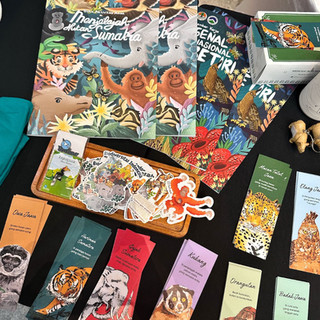Strengthening Network

Together for Wildlife: A Collaborative Landscape Approach
Orangutans, elephants, tigers, and rhinos are iconic wildlife species that reflect the richness of Indonesia’s biodiversity. But across the landscape, they face growing threats—from habitat loss and land-use change to poaching and human-wildlife conflict.
These species are known as umbrella species, meaning that protecting them also safeguards countless others and the ecosystems they share. Many of these species overlap in the same forest landscapes—especially in Sumatra—making an integrated conservation approach not just necessary, but powerful.
In 2019, FORINA (Indonesian Orangutan Conservation Forum) initiated a collaboration with two other national conservation forums—Forum Konservasi Gajah Indonesia (FKGI) and Forum HarimauKita (FHK)—to explore joint action across shared habitats. This multi-species collaboration began with mapping key population pockets where orangutans, elephants, tigers, and rhinos coexist. These include:
1. Western and Eastern Leuser, Aceh–North Sumatra: A stronghold for Sumatran orangutans, tigers, elephants, and rhinos—home to important orangutan metapopulations like Leuser Barat, Rawa Tripa, Singkil, Batu Ardan/Siranggas, and Sikuaping.
2. Jantho and Bukit Tigapuluh: Habitats shared by Sumatran orangutans, elephants, and tigers.
3. Batang Toru, North Sumatra: The only known habitat of the Tapanuli orangutan, which also supports Sumatran tigers.
Together, FORINA, FKGI, and FHK identified eight joint initiatives to move from coordination to action:
1. Shared Species Database: A unified system to track in-situ and ex-situ populations.
2. Education & Awareness: Outreach through workshops, social media, exhibitions, and campaigns.
3. Corridor Feasibility Studies: Mapping and planning safe wildlife movement routes.
4. Early Warning Systems: Developing local models to reduce human–wildlife conflict.
5. Collaborative Patrols: Engaging communities and rangers in joint habitat protection.
6. Compliance Monitoring: Supporting permit holders in meeting biodiversity obligations.
7. Law Enforcement Capacity: Strengthening institutional ability to protect wildlife.
8. Recognition & Acknowledgement: Highlighting contributions from individuals and organizations driving conservation efforts.
In Kalimantan, FORINA has expanded this approach by mapping orangutan habitats along with other keystone species—such as proboscis monkeys, rhinos, elephants, and clouded leopards—to better understand ecosystem connectivity across regions.
Beyond these forums, collaboration continues to grow with conservation partners and civil society groups, especially in joint education and public awareness programs.
This multi-species collaboration marks a new chapter for FORINA—bridging conservation efforts across species and landscapes. We’ve also worked closely with the Directorate of Conservation Planning to help integrate the presence of threatened species and habitats into national land-use and spatial planning discussions.
It’s a big step toward a future where wildlife conservation is truly connected—across species, sectors, and landscapes.

